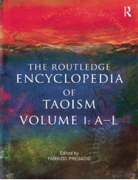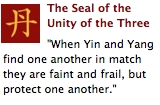Daojia
Taoism; "Lineage(s) of the Way"
Reproduced from:
Isabelle Robinet, "Daojia"
In The Encyclopedia of Taoism, vol. 1, pp. 5-8
Edited by Fabrizio Pregadio
Routledge, 2008
The Encyclopedia of Taoism
● Table of Contents and List of Contributors
Sample Entries
● Daode jing (Scripture of the Dao and Its Virtue)
● daojia (Taoism; "Lineage[s] of the Way")
● daojiao (Taoism; Taoist teaching; "Teaching[s] of the Way")
● Daozang (Daoist Canon) and Subsidiary Compilations
● jiao (Offering)
● jindan (Golden Elixir)
● Lingbao (Numinous Treasure)
● Quanzhen (Completion of Authenticity)
● Shangqing (Highest Clarity)
● Tianshi dao (Way of the Celestial Masters)
The term daojia is a topic of debate among scholars, mainly concerning whether early Taoism constituted a "school" or "lineage," as the term jia seems to imply, and the distinction between daojia and daojiao, which is often understood to mean the religious forms of Taoism. The term daojia itself originated with Han historiographers as a bibliographic label, but has also been applied to texts related to Taoist religion in such modern compilations as the Sibu beiyao (Complete Essentials from the Four Sections of Literature) and the Sibu congkan (Collectanea from the Four Sections of Literature).
According to many modern interpreters, daojia began with Laozi (☞ pictures) and Zhuangzi. Some scholars suggest that this classification is an ex post facto creation, arguing that Laozi and Zhuangzi were independent thinkers and that — at least as far as the first seven, authentic chapters of the Zhuangzi are concerned — there is no evidence that they influenced each other. Similar circumstances, however, are common to several schools of philosophy and religion both in China and elsewhere. Confucius himself intended only to transmit and restore the lost order of the Zhou kingdom, with no awareness that he was beginning a school of thought. Moreover, the so-called daojia is only one of the roots of what came to be Taoism.
The main point, therefore, is not whether the daojia was a school — most specialists agree that it was not. Even though the features of daojia are found mainly in the Daode jing and the Zhuangzi, other texts and authors reflect these trends, each with its own emphasis. Some of the main Warring States thinkers and texts belonging to this group are Shen Dao (as reported in the Zhuangzi, j. 33), Yang Zhu, Heguan zi, the Neiye (Inner Training) and Xinshu (Arts of the Heart) chapters of the Guanzi, and the Daoyuan (Dao, the Origin; trans. Yates, Five Lost Classics, 171-77) scroll of the Mawangdui manuscripts. Later, Han syncretism, as expressed in the Huainan zi and by the Huang-Lao school, tended to combine the thought of the Daode jing and the Zhuangzi with a philosophical exploitation of the Yellow Emperor (Huangdi) and certain features of the legalist school of thought. From the 3rd century onward, the Xuanxue (Arcane Learning) thinkers and the Liezi can be related to the daojia. In the Six Dynasties and the Tang periods, Taoist classics like the Qingjing jing, the Xisheng jing, the Yinfu jing, the texts on neiguan (inner observation) and zuowang (sitting in oblivion), and the Chongxuan (Twofold Mystery) trend of thought are much indebted to it. The main points that unite these thinkers and texts are outlined below.
The Notion of Dao
First, the term daojia and its translation as "Taoism" derive from a new significance given to the word dao in the Daode jing, the Zhuangzi, and other texts. The basic meanings of dao are "way" and "to say," hence "the way one should walk and that is taught," "guideline," and "method." In these texts the term took on a new meaning of Ultimate Truth, in the sense of the unique way that subsumes all the multiple human ways, and that is primal because nothing was before it and it is the source of everything. According to the Daode jing and the Zhuangzi, the Dao cannot actually be named and is beyond anything that can be grasped or delimited, but is open to personal experience. Both texts favor an apophatic approach that was entirely absent in the other teachings of their time. Having no form, because it exists before anything has taken form, the Dao can take all forms: it is both formless and multiform, and changes according to circumstances. No one can claim to possess or know it. As the source of everything, it is inexhaustible and endless; its Virtue or Efficacy (de) is strength and light, and encompasses all life. Both the Daode jing and the Zhuangzi stress the necessity of following the natural order of the Dao and of Nourishing Life (yangsheng), maintaining that this is sufficient for one's own well-being.
Return to the Origin
The Daode jing and the Zhuangzi share the same concern for the origin of things. Unlike any other trend of thought in the Warring States period, these texts emphasize the necessity of "returning" (fan or fu) to the Dao, i.e., turning within oneself toward the Origin. This is essential to know and experience the Dao, and to fully understand the particular with regard to the two polar aspects of the Dao: indeterminate totality and receptive unity, on one side, and existence as organic diversity, on the other. Turning within oneself affords the quiescence required to experience the Dao. It consists in concentrating and unifying one's spirit (shen) and will (zhi) on this experience, and in being receptive and compliant in order to receive this Dao. Hence the practice of concentration on the One (yi), seen throughout the history of Taoism. This concentration means freeing oneself from desires, emotions, and prejudices, renouncing the conceptual self, and not getting entangled in knowledge and social concerns. The goal is to return to one's original nature and to pristine simplicity of the authentic state of things, which Taoists sometimes call the "great clod" (dakuai). It is related to an intuitive vision of the world as a unified whole, and a perception of the value and the natural strength (qi) of life. This is not merely a reflection of the limitations of language, as some have claimed, but an intuitive, personal and sometimes mystical awareness that goes beyond language, conceptual thought, and social or moral practices and doctrines.
Based on this vision, the Daode jing and especially the Zhuangzi offer an ideal of the human being that has deeply influenced Chinese thought. The Taoist saint (shengren) is before and beyond appellation and individual existence, and possesses cosmic and nearly divine stature and powers. He is an incarnation of the Dao and its Virtue, and dwells on the border between humanity and the Dao.
Is Taoism Philosophical?
Another issue in the debate among scholars is whether or not daojia is "philosophical." Indeed, Zhuangzi and the Taoist saint are neither pro- nor antiphilosophical. They dwell in a open space where one thinks without being caught up in thought, and sees in a multifaceted "perspectivist" way. In addition, there is a fantastic vein in the Zhuangzi that is not philosophical and that was later developed in Taoism, particularly by the Shangqing school.
Daojia has also been labelled "non-purposive," "non-instrumental," and "contemplative," but these definitions are inadequate for three reasons. First, some trends of daojiao, or so-called "religious Taoism," are also non-purposive and contemplative. Second, concentration on the Dao or Oneness, and renunciation of social and personal values and activities, necessarily imply some "purposive" techniques of self-cultivation that the daojia texts often allude to. Third, various early daojia texts refer to political applications. The main difference between daojia and daojiao is perhaps that daojiao primarily aims at establishing a connection with the sacred, either as a relationship with deities and spirits or as the attainment of personal transcendence. The question of immortality is related to this point.
The daojia dimension of Taoism is absent in several Taoist trends and texts, and others appropriated the Daode jing without much regard for its many possible meanings. The Xiang'er commentary exemplifies this attitude. Nevertheless, the philosophical spirit and features embraced by the term daojia are apparent throughout most of the history of Taoism, beginning with the Taiping jing (Scripture of Great Peace), which may be the earliest extant daojiao text. With Yin-Yang and wuxing cosmology, the daojia has given Taoism one of its most basic conceptual frameworks, without which no religion can have a structured and coherent worldview.
Isabelle ROBINET
















